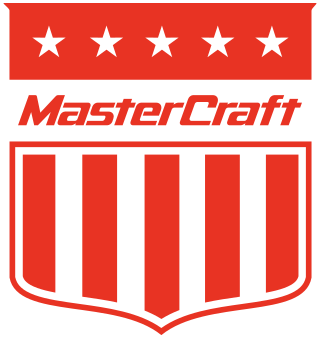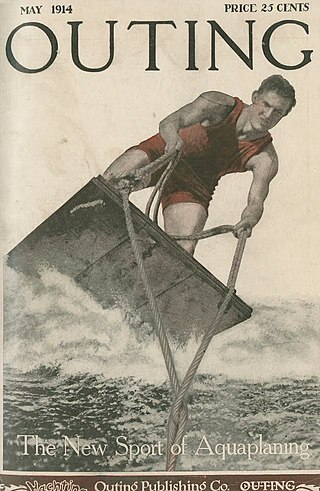
A kneeboard is a board ridden in a kneeling stance. Kneeboards are ridden in ocean surf, or while being towed behind a boat on a lake or river. [1]

A kneeboard is a board ridden in a kneeling stance. Kneeboards are ridden in ocean surf, or while being towed behind a boat on a lake or river. [1]
Kneeboard riders generally wear life jackets or wetsuits and catch the wave by paddling and kicking or dipping their hand into the water. Advantages to kneeboarding include an extremely low center of gravity, less wind resistance, the ability to ride higher and further back in the tubes, and taking off on a steeper part of the wave.
Towed kneeboarding is an offshoot of kneeboard surfing; kneeboard riders compete tricks, and expression session events. Towed kneeboards have a padded deck contoured to the shape of the shins and knees and a strap holds the rider in place. Towed kneeboarding declined in popularity with the advent of wakeboarding and other modern watersports. However, it still enjoys popularity among water skiers and newer models of the kneeboard remain in production. A kneeboard is a good piece of equipment to start with for boat-towed sports. The low center of gravity often makes it easier to use than a waterski or wakeboard, which both require standing up.
Surf kneeboard innovators include George Greenough, Steve Lis, Peter Crawford and Ron Romanosky. Till Wipperfuerth is one of the actual top performers in kneeboarding, since he became champion of the Tunilake Kneeboard Masters.

Wakeboarding is a water sport in which the rider, standing on a wakeboard, is towed behind a motorboat across its wake and especially up off the crest in order to perform aerial maneuvers. A hallmark of wakeboarding is the attempted performance of midair tricks. Wakeboarding was developed from a combination of water skiing, snowboarding and surfing techniques.
Boardsports are active outdoor sports that are played with any sort of board as the primary equipment. These sports take place on a variety of terrains, from paved flat-ground and snow-covered hills to water and air. Most boardsports are considered action sports or extreme sports, and thus often appeal to youth. Some board sports were marginalized in the past. However, many board sports are gaining mainstream recognition, and with this recognition, they have gotten wider broadcasting, sponsorship and inclusion in institutional sporting events, including the Olympic Games.

Water skiing is a surface water sport in which an individual is pulled behind a boat or a cable ski installation over a body of water, skimming the surface on two skis or one ski. The sport requires sufficient area on a stretch of water, one or two skis, a tow boat with tow rope, two or three people, and a personal flotation device. In addition, the skier must have adequate upper and lower body strength, muscular endurance, and good balance.

Kiteboarding or kitesurfing is a sport that involves using wind power with a large power kite to pull a rider across a water, land, snow, sand, or other surface. It combines the aspects of paragliding, surfing, windsurfing, skateboarding, snowboarding, and wakeboarding. Kiteboarding is among the less expensive and more convenient sailing sports.
Kneeboarding is a discipline of surfing where the rider paddles on his or her belly into a wave on a kneeboard, then rides the wave face typically on both knees. The typical kneeboard is between 150 and 200 cm in length, with a wide round nose and constructed of Glassfibre over a polyurethane foam core. Kneeboard designers however are known for their wild experimental excess and so most modern materials including various aerospace elements such as Titanium alloys, carbon fibre and kevlar in epoxy matrices are not unusual. Modern kneeboards may have a rubber pad for the rider's knees, preventing undue wear of the knees, also preventing slipping to help the rider maintain control. Kneeboarders also typically use swimfins and an ankle surfleash.

Kneeboarding is an aquatic sport where the participant is towed on a buoyant, convex, and hydrodynamically shaped board at a planing speed, most often behind a motorboat. Kneeboarding on a surf style board with fin(s) is also done in waves at the beach. In the usual configuration of a tow-sport kneeboard, riders kneel on their heels on the board, and secure themselves to the deck with an adjustable Velcro strap over their thighs. Most water ski kneeboards do not have fins to allow for easier surface spins. As in wakeboarding or water skiing, the rider hangs onto a tow-rope. The advantages of kneeboarding versus other tow-sports seems to be an easier learning curve and a sense of being closer to the water when falls occur.

Laird John Hamilton is an American big-wave surfer, co-inventor of tow-in surfing, and an occasional fashion and action-sports model and actor. He is married to Gabrielle Reece, a former professional volleyball player, television personality, and model.

The MasterCraft Boat Company is an American manufacturer of luxury high-performance boats. The company was founded in 1968 in Maryville, Tennessee, and is currently headquartered in Vonore, Tennessee. MasterCraft boats are used in waterskiing, wakeboarding and wake surfing. The company has also produced several boats that are not focused on water sports, such as the NauticStar line of fishing boats.

Cable skiing is a way to water ski, in which the skier's rope and handle are pulled by an electrically driven cable, whereas traditionally a waterskier is pulled by a motorboat. The mechanism consists of two cables running parallel to one another with carriers between them every 80 metres. The carriers are metal tubes that can hook up tow ropes with riders. Tow ropes are detached and attached at the same time without slowing the system down, which is a main reason for its high efficiency. With a main cable of 800 metres long, 10 riders can waterski or wakeboard at the same time. The speed of the main cable can be up to 38 mph (61 km/h), and slalom skiers can reach much higher speeds. The most common speed is 19 mph (31 km/h), which suits wakeboarders best.

Peʻahi is a place on the north shore of the island of Maui in the U.S. state of Hawaii. It has lent its name to a big wave surfing break, also known as Jaws.
Skurfing is a towed water sport in which an individual is pulled behind a boat on a tow rope. The sport uses a skurfboard, which is a floating platform the user balances on, similar to a surfboard but typically much shorter, with two foot-straps that prevent falling off the board and three fins positioned on the bottom that make it easier to maneuver when the board is being towed. The word itself is a portmanteau of skiing and surfing. Skurfing is often considered the precursor to wakeboarding.

Wakesurfing is a water sport in which a rider trails behind a boat, riding the boat's wake without being directly pulled by the boat. After getting up on the wake, typically by use of a tow rope, the wakesurfers will drop the rope, and ride the steep face below the wave's peak in a fashion reminiscent of surfing. Wakesurfers generally use special boards, designed specifically for wakes.

The sit-down hydrofoil, first developed in the late 1980s, is a variation on water skiing, a popular water sport. When towed at speed, by a powerful boat or some other device, the board of the hydrofoil 'flies' above the water surface and generally avoids contact with it, so the ride is largely unaffected by the wake or chop of the water and is relatively smooth. The air board is a modified hydrofoil where the skier stands up.

Wakeboard boats also known as wakeboats, surfboats or tow boats are designed to create a large, specially shaped wake, for a wakeboarder to jump the wakes from side to side doing aerial tricks. They developed from the Runabout type.
Centurion Boats, owned by Fineline Industries, is a manufacturer specializing in the production of water sports boats, primarily tow boats for wakesurfing and wakeboarding. It was founded by current owner Rick Lee. Its headquarters and manufacturing operations are in Merced, California.
Danny Harf is an American professional wakeboarder and sports video producer.

Aquaplaning is a surface water sport which involves riding a board (aquaplane) over the surface of a body of water towed behind a motorboat.
Horse surfing is an extreme sport invented in 2004. It requires two people, a horse, and a board. Horse surfing involves one person riding either kite-board, surfboard, wake-board, or skim-board, while being towed behind a horse, ridden by a second person, through shallow water, at speeds up to 40 miles per hour (64 km/h). After originating in England the first official horse surfing competition was held in 2006 in La Baule, France, and over the last 14 years the sport has continued to spread internationally. Today there are several competitions with globally established rules and categories.